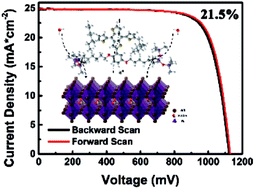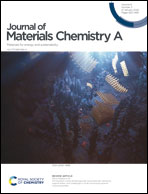Application of a new π-conjugated ladder-like polymer in enhancing the stability and efficiency of perovskite solar cells†
Abstract
In this study, a new p-type π-conjugated ladder-like polymer, poly(3,3′-(((2-(4,8-bis(5-(2-ethylhexyl)thiophen-2-yl)-6-methylbenzol[1,2-b:4,5-b′]dithiophen-2-yl)-5-methyl-1,4-phenylene)bis(oxy))bis(hexane-6,1-diyl))bis(1,1,1,3,5,5,5-heptamethyltrisiloxane)) (P-Si), has been designed for SnO2-based perovskite solar cells. Our investigation reveals that this π-conjugated ladder-like polymer system decorated with hydrophobic alkyl chains and siloxane chains is likely the reason for the improvement in the surface morphology and crystallinity of the perovskite films, leading to reduced defect states and enhanced device stability. In addition, P-Si with a suitable highest occupied molecular orbital energy level (−5.41 eV) can act as a hole transport medium between the perovskite and spiro-OMeTAD to enhance the excellent hole transportation. As a result, power conversion efficiency (PCE) as high as 21.5% with 21.3% steady-state PCE was achieved. Typically, the device with P-Si can retain 98% of the original average PCE after being stored in an ambient environment with 20% relative humidity for 120 days, indicating its good long-term stability. Furthermore, after aging for 100 h under illumination at the maximum power point in a nitrogen atmosphere, the P-Si modified device retains over 98% of its initial performance.



 Please wait while we load your content...
Please wait while we load your content...